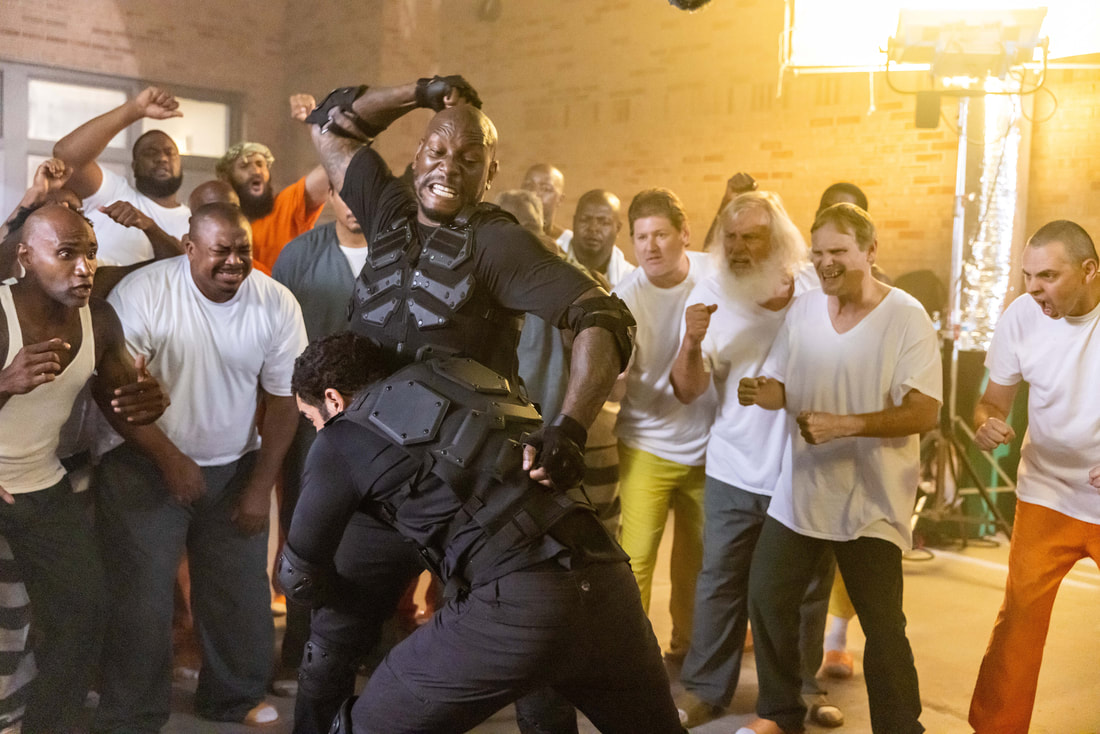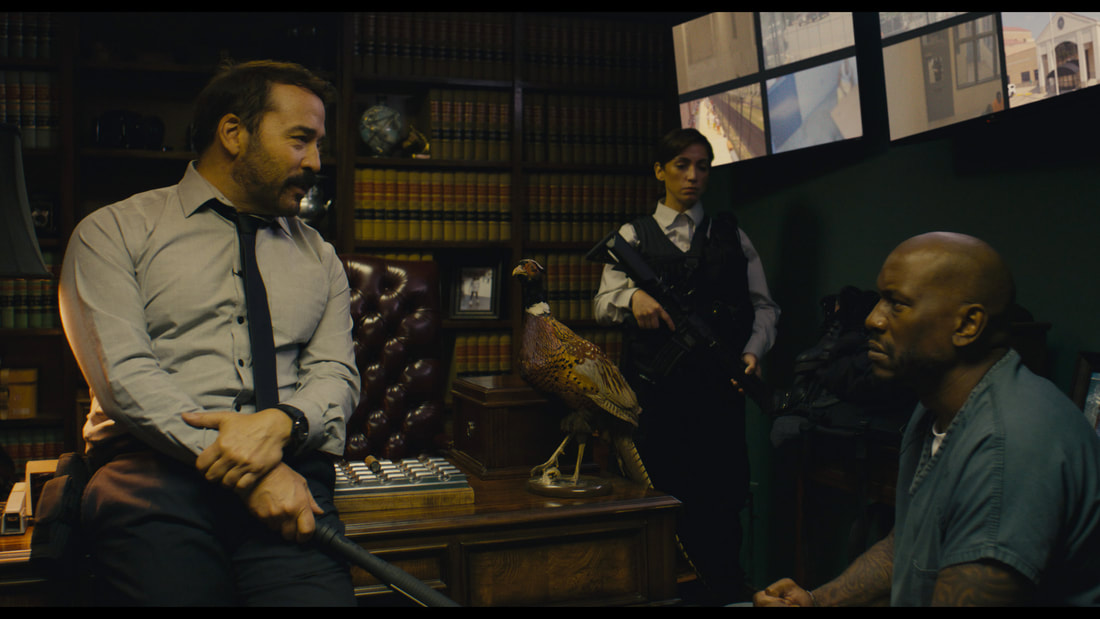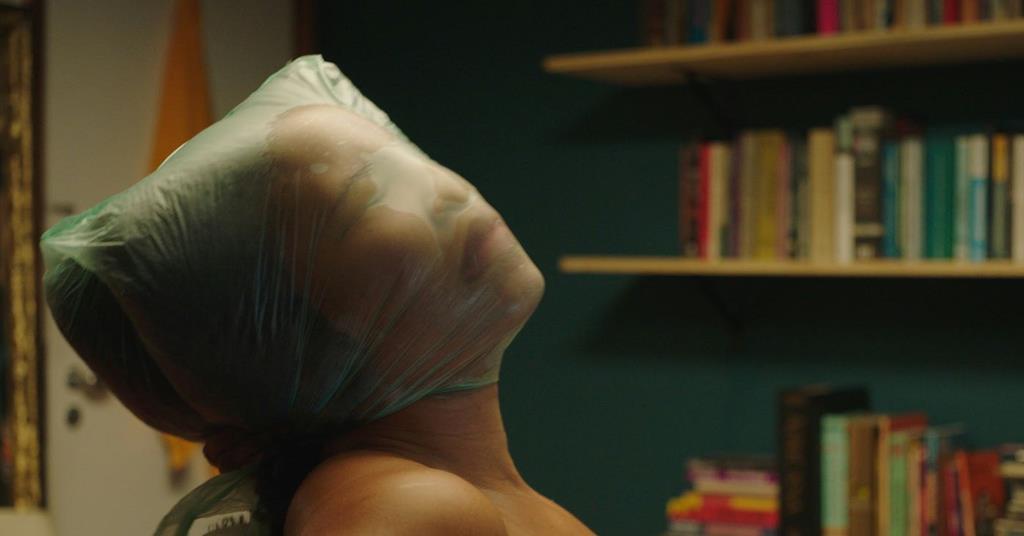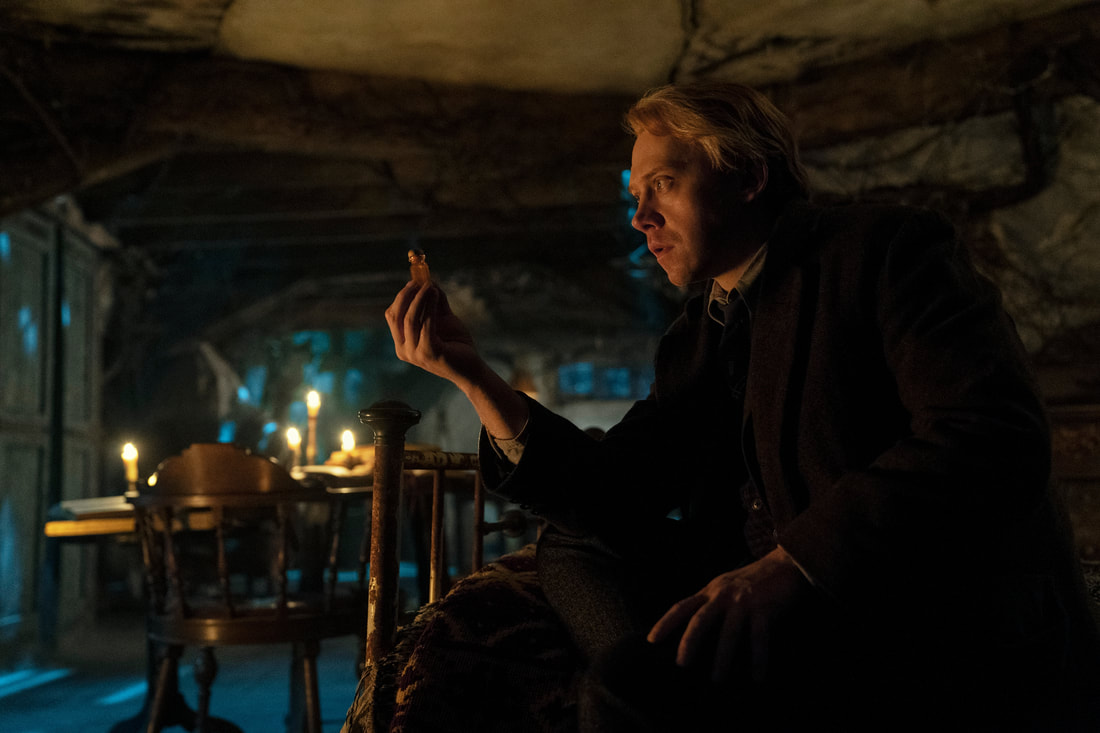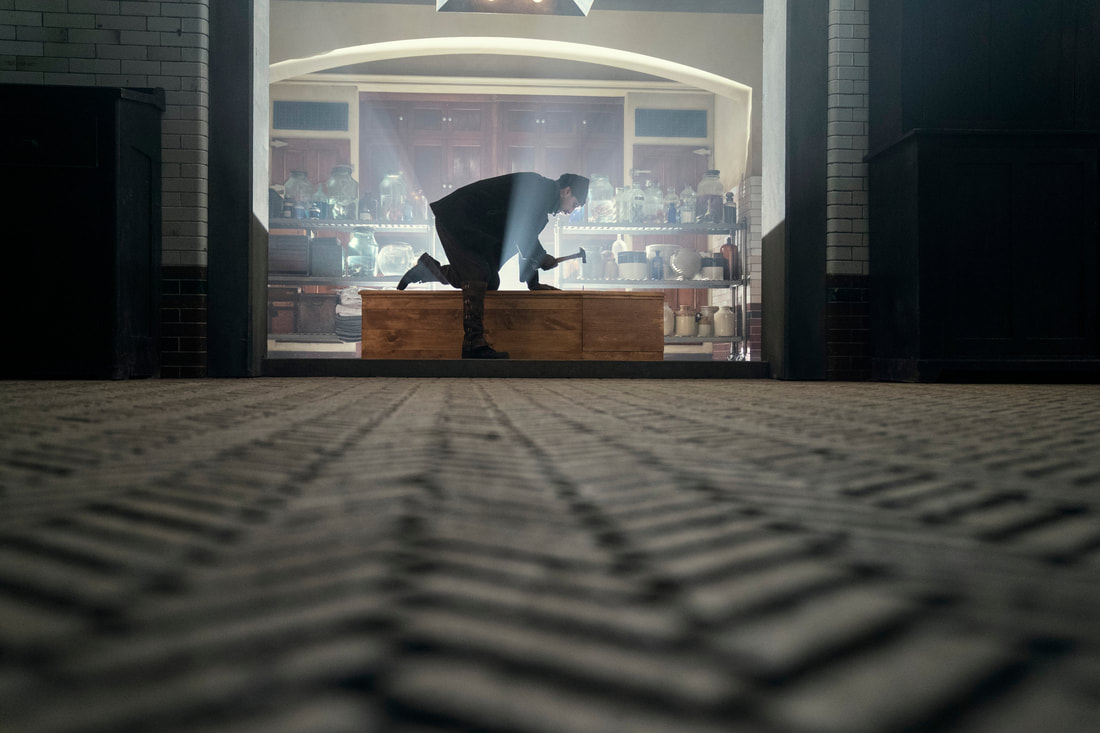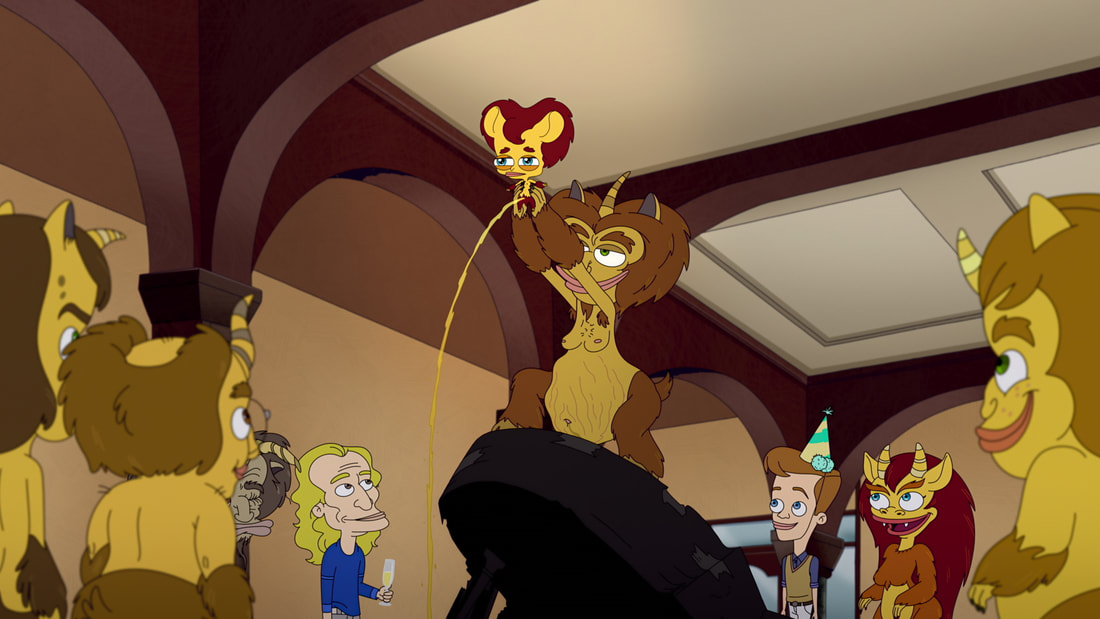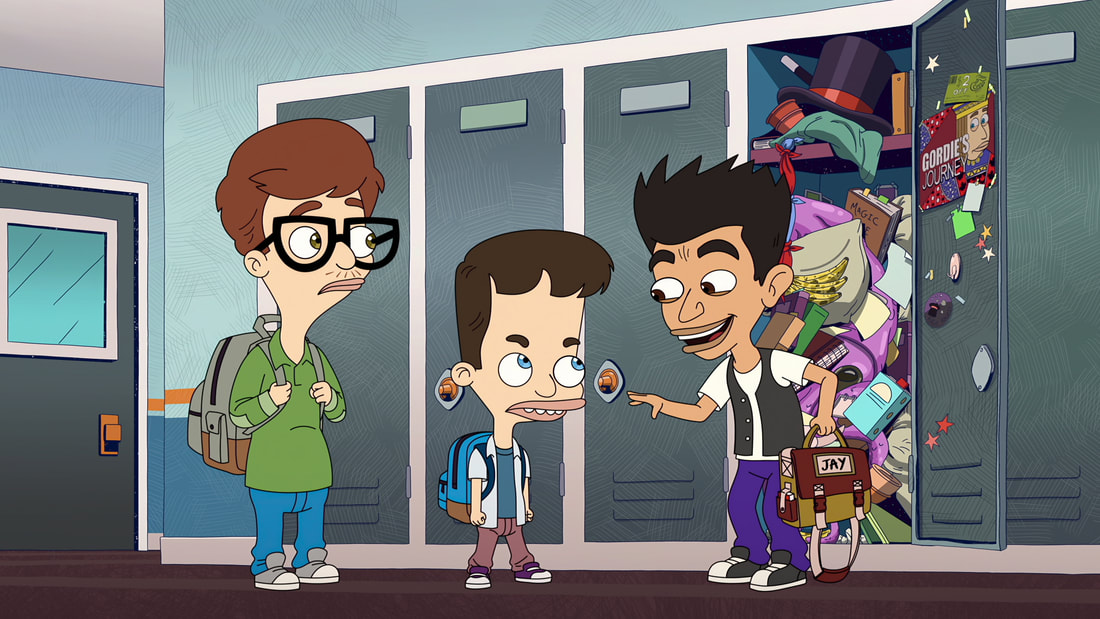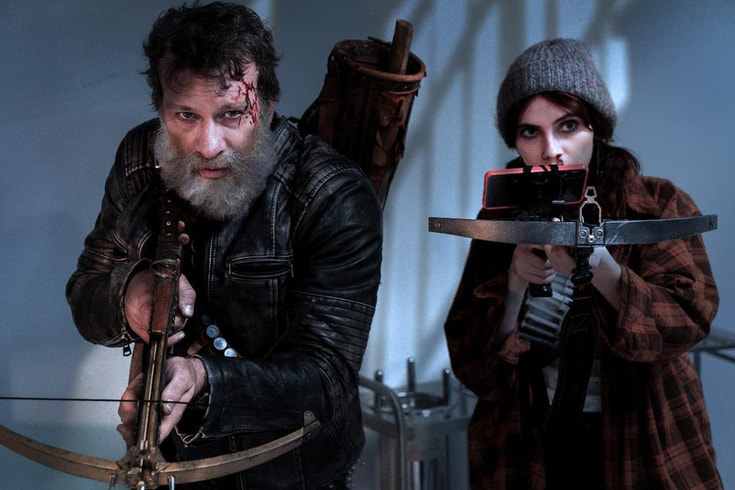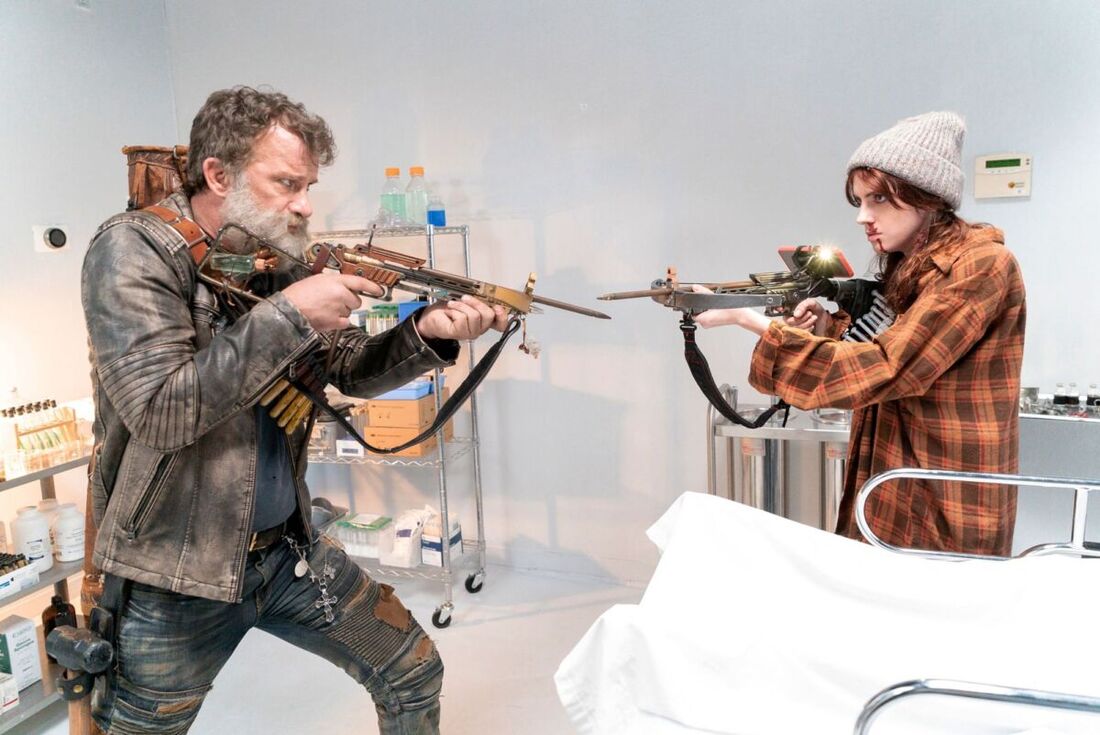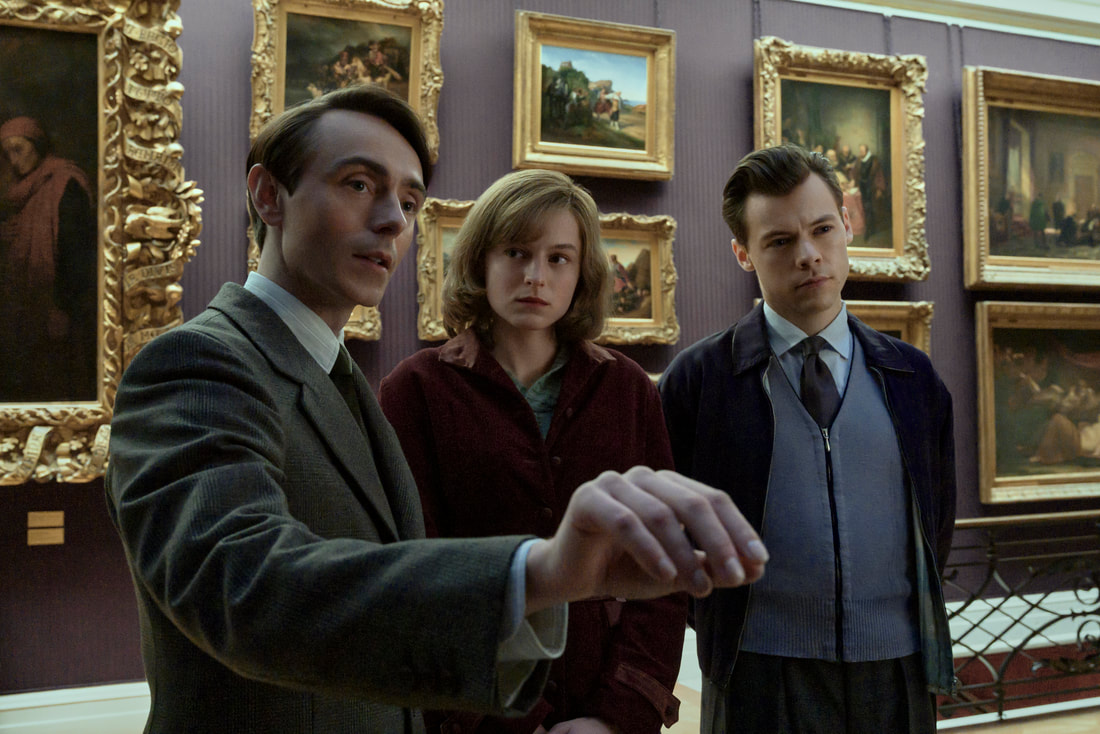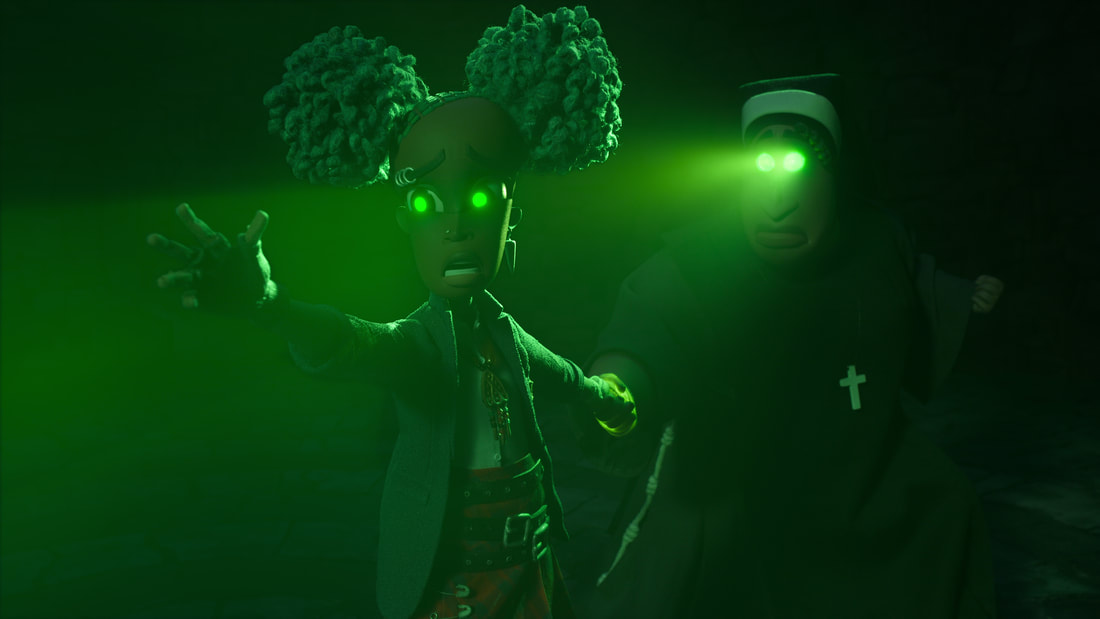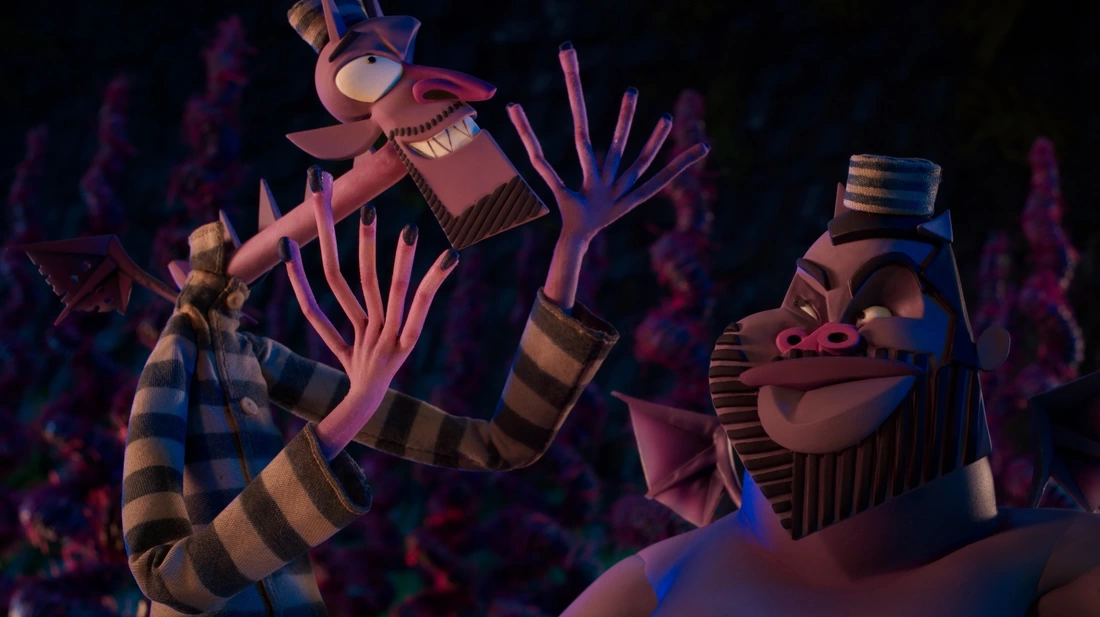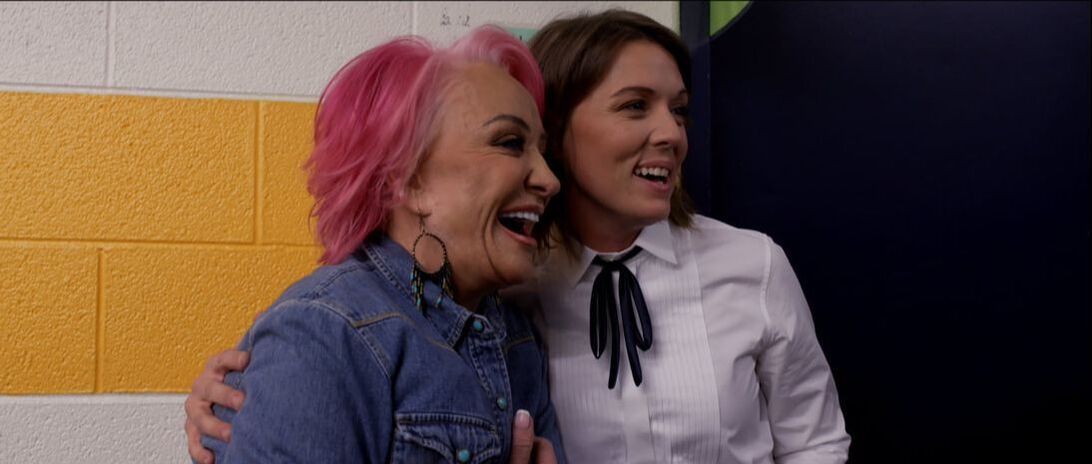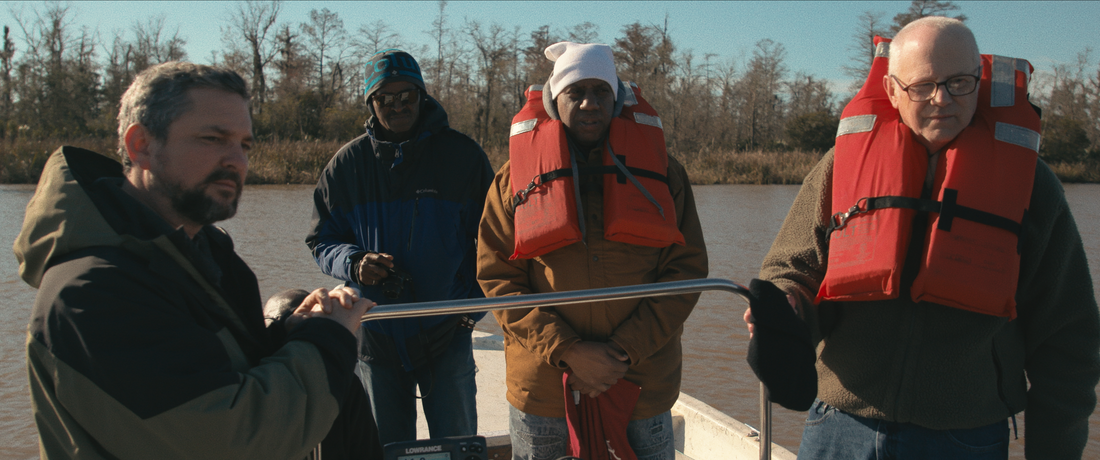|
Review by Cole Groth
Every year, America is plagued with dozens of cheap action flicks with a C-list, or previously A-List, actor trudging along for a paycheck. For a good reason, Bruce Willis and Nicholas Cage have tarnished their reputations by appearing in these films. Typically, these directionless films offer little to say or have no heart. While The System bolsters some cheap action and a series of one-note characters, it manages to have a decent message and a solid emotional punch, making it an unusually brilliant film in what would otherwise be bargain bin material.
The System follows a former Marine and father-turned-criminal, Terry Savage (Tyrese Gibson), a man who gets caught up in a drug bust and is forced to go undercover in prison, revealing the dark world of the private prison system. As he gets further into his sentence, he gets involved in an underground fighting ring, which is enabled by the regulation-less nature of private prisons. The writer/director, Dallas Jackson’s script, makes sure to spotlight the corruption that goes on within these prisons, and it works rather well. Jackson’s decision to film inside a real jail adds to a sense of realism that’s very important in a film like this. There’s not much subtlety to be found within the 97-minute runtime, but sometimes messages like these don’t need to be very subtle. The main draw for audiences is the action. In the walls of the plain-looking prison lies a dungeon where the inmates meet and bet on a simple fighting match between various prisoners and guards. It’s well-choreographed for the most part and is wildly fun at times, in part to Derrick Hodge’s thumping score and David Conk’s choreography. Each fight is hosted by Joker (Lil Yachty), a deranged man with this Mad Max energy in the way he loves violence. Each punch looks pretty good, but some very bad foley choices undermine the realism. A simple punch will be followed up with a crunch that sounds like somebody’s ribs have just exploded. It’s easy to overlook these poor stylistic choices in the grand scheme of things, but they’re noticeable moments of weak filmmaking. The simple fight sequences are rather well done, but the large-scale, much deadlier action scenes are sloppy and uninteresting. There are far too many films that want extreme action for the sake of entertainment, but it doesn’t make the film that much better.
Terry is fighting for his freedom to see his daughter again, making him a fascinating character to follow. However, Tyrese Gibson’s performance, like other actors, isn’t able to do justice to these theoretically complex characters. Terrence Howard’s performance as a prison veteran is one of the best, but he’s not explored enough to be a fully-fleshed out supporting character. Warden Lucas (Jeremy Piven) suffers from the same problem. He’s not given enough of a story and is a wildly evil man with no real motivations. Piven’s performance accurately reflects the evils of a total psychopath. Still, there’s a missing link drawn by the film’s end because he’s given just enough character development to feel frustratingly undeveloped by the end. Some other characters round out the cast, and they all feel too dull to discuss thoroughly.
There’s a fine line to be drawn between a complex social issue drama and an over-the-top action film, and The System walks this line like a drunkard convincing a cop that they’re sober. It’s sometimes an experience that feels amateur all around, but it has a lot going on that’s impressive. The cinematography is fine, and the editing is fine, but it could be a lot better. One of the best parts about this film was the pacing. It’s a fast, fun, action-driven film with a solid emotional undertone. It importantly focuses on how private prisons are a form of modern slavery and might also satisfy your craving for adrenaline-pumping action. The System hits theaters on October 28 and VOD on November 4. Rating: 3/5
0 Comments
[NewFest 2022] RULE 34 -- Sexual Liberation in the Age of #MeToo and FIFTY SHADES OF GREY10/25/2022 Review by Tatiana Miranda Julia Murat's award-winning film Rule 34 begins with a bang, quite literally. The film derives its name from the online concept that if something exists, there is bound to be a porn version of it. While it's less commentary on the rule itself, the film does play with the duality of situations as they exist in real life and within sexual scenarios. Rule 34, like its namesake, does not hold back in terms of blatant eroticism, opening immediately with shots of cam-girl Simone as she performs for her online audience. It's shocking, and before you know it, it's over, with Simone dressing for her first day of college. With the shut of her laptop, she announces that now that she is starting college, she is done with pornography, instead choosing to focus on becoming a public defender for domestic abuse cases. Simone's story is told through vignettes as she attends classes and spends time with her peers, including the occasional video chat with her long-term and similarly sexually liberated friend. Slowly though, through her meetings with physical abuse victims and injuries gained from kickboxing, Simone gains a penchant for pain. In her polyamorous relationship with Coyote and Lucia, she explores this aspect of her sexuality through BDSM and consensual non-consensual scenarios. After a scene between Simone and Lucia reminiscent of the abuse cases Simone is dealing with, she realizes that her fantasies must go beyond her partners to be fulfilled. With a return to her cam-girl ways, Simone goes off the deep end, sharply contrasting her experiences with asphyxiation and sadomasochism with the depictions of domestic abuse that she is meant to condemn. Rule 34 is straightforward with its depiction of pornography and pain-based sexual fantasies. Nothing about the film comes off as obscene or appealing, even as Simone's entire naked body is displayed and toyed with. Instead, the subject is shown with a sense of anxiety and wary condemnation. It doesn't say that these types of kinks are necessarily bad, but they can lead to unsafe situations without proper communication and boundaries.
Ultimately the film is a clear-cut reflection on modern sexuality and the fine line between sexual liberation and falling into the hands of the patriarchy. Even with its focus on Brazil's domestic abuse issues, as the country has the world's fifth-highest femicide rate, the subject of Rule 34 goes beyond its geographic borders and allows for introspection into the many facets of sexuality, especially regarding the internet. Rule 34 screened at the 2022 edition of NewFest, which runs October 13-25. Rating: 4/5
Review by Dan Skip Allen
Guillermo Del Toro is a filmmaker who likes to create weird and out-of-the-ordinary types of characters and stories. His early work --Chronos, The Devil's Backbone, and Pan's Labyrinth — are prime examples of this style. His last film Nightmare Alley, was a little more straightforward, though. He gets back to the weird and out-of-the-ordinary stories and characters with the help of some relatively known directors, actors, and writers who have a similar sense of taste in storytelling as Del Toro does in Cabinet of Curiosities.
Cabinet of Curiosities is an anthology series produced and hosted by Guillermo Del Toro. It features eight episodes from various directors, each with a distinct eye for the macabre, including Ana Lily Amirpour, Jennifer Kent, and Cathrine Hardwicke. They all happen to be female directors. This series is similar to The Twilight Zone or Alfred Hitchcock Presents, albeit to another level. It is a bloody, gruesome show that goes beyond the boundaries of what can be seen on television or, in this case, streaming. The best episode of the series is "The Murmuring," about a couple of bird watchers, Edgar and his wife (Andrew Lincoln, Essie Davis). They go to a secluded island to study birds but get more than they bargained for involving the previous residents of a house they are staying at on the island. This is episode eight, and I thought the direction by Jennifer Kent and the look and feel of the episode was good. The story is based on an original concept by Guillermo Del Toro and has some nice suspenseful moments. "Dreams in the Witch House" has many moving parts, but like "The Murmuring," it has an underlying story that keeps the viewer in suspense. This one has some cool visual effects and creepy cinematography. Catherine Hardwick kept the story by Mika Watkins, based on a short story by H.P. Lovecraft, moving nicely. There weren't a lot of slow moments. The acting by all, including Rupert Grint (the Harry Potter franchise) and Ismael Cruz Cordova (The Rings of Power), was very good. And "The Outside," directed by Ana Lily Amirpour and starring Kate Micucci, Martin Starr, and Dan Stevens, was a very interesting episode. It really uncovered a thing in this country and the world that has been going on for a while: how beauty is only skin deep, but people, especially women, are so concerned by it. The worst of the eight episodes was "The Viewing," directed by Panos Cosmatos, not because of the episode's look but how it ended. It started interesting, the setting was beautiful and fascinating, and the cast was very good, but the ending wasn't there. Cosmatos and Aaron Stewart Ahn just dropped the ball on the ending of this episode. Another episode with a bad ending was "Graveyard Rats," directed by Vincenzo Natali. The main character, played by David Hewlett, was engaging, and his plight was interesting to follow along with. The claustrophobia was pretty scary at times, and the rats were a bit creepy. It just didn't feel like it ended right.
"Lot 36," directed by Guillermo Navarro and starring Tim Blake Nelson, isn't anything special. I liked the performance by Nelson as this shady storage lot dealer and treasure hunter. I always like seeing him in films and television shows. It has some cool visual effects and a fascinating story based on a short story by Henry Kuttner.
Another episode called The Autopsy was bizarre, but it starred Academy Award winner F. Murray Abraham. It's a pleasant surprise to see him in things these days. He's not in a lot of films or television shows anymore. The direction by David Prior was a bit disjointed, though. I just couldn't get a good feel for this episode. "Pickman's Model" was one as I was watching it I had high hopes for. The cast, including Ben Barnes and Chrispin Glover, was pretty good in it, but the idea behind the story was the real aspect I liked. The director Keith Thomas, adapting another H.P. Lovecraft short story, did a good job showing the creepiness of the world he was setting up. It just didn't come all the way home for me. Guillermo Del Toro has created a great series of creepy, weird tales of suspense and terror. He has assembled a great group of directors with unique storytelling styles. The cast in the episodes was very good as well. Actors like Nelson, Abraham, and Kate Micucci did an excellent job in their various episodes. This series captured the feel of classic shows like The Twilight Zone and Alfred Hitchcock Presents but added in Del Toro's signature flare for the dramatic and odd spine-tingling terror he is known for. These creators channeled him and his ideas of what is scary and creepy. The audience watching should be afraid while viewing these episodes. It is one of the best things I've seen this Halloween season. Guillermo Del Toro's Cabinet of Curiosities streams on Netflix beginning October 25, with new episodes airing daily through October 28. Rating: 4/5 THE WHITE LOTUS (Season 2) -- A Rushed and Inferior, Yet Still Entertaining Expansion of the World10/24/2022
Review by Sean Boelman
The White Lotus took everyone by storm so much that HBO decided it would no longer be a miniseries, but an anthology series with more seasons taking place at different resorts around the world. The second season of the show may not live up to the strangely compelling heights of the first outing, but it still offers some very funny moments.
This season follows the guests of a picturesque resort in Italy in the week leading up to a tragedy. It follows the same basic premise of the first season — just changes the location to another one of the White Lotus brand of resorts, allowing for more of the same hijinks that fans came to love. The visuals of the series are also just as strong as they were the first time around, this time trading the tropical Hawaii setting for the gorgeous coast of Italy. It’s almost ironic that the series is shot so gorgeously that it will make you want to take a vacation to Italy immediately, because it is satirizing the people who do just that. There’s definitely some very witty commentary here about the wealthy and the lives of exuberance they live. However, whereas the first season felt like it had an uncanny understanding of the people it pointed a magnifying glass on, this season feels like it is merely dealing in archetypes.
What this season is missing that the first season excelled in was a compelling cast of characters. While the characters in the first season weren’t exactly likable for the most part, they were at least interesting. Here, the characters are all to some extent whiny, annoying, or depraved, and it’s hard to find anyone to latch onto.
The only returning main cast member is Jennifer Coolidge, whose performance was a hilarious fan-favorite in the first season, but she is given disappointingly little to do here comedically. This would have been forgivable had her arc been more interesting, but she has a pretty standard “bored housewife” storyline with only a few twists. Of the new ensemble, F. Murray Abraham is the clear highlight, proving that he is still one of the greatest actors alive today. He has the most charisma out of anyone in the cast, and that allows him to get the most natural laughs. There are plenty more recognizable faces, from Theo James to Michael Imperioli and more, but they all feel wasted in a series that doesn’t understand their talents. This new season of The White Lotus pales in comparison to the brilliance of the first season, but that doesn’t mean it isn’t still entertaining. Ultimately, it feels as if it was too rushed into production to ensure it came out while the first season was still popular, making it much less effective. The White Lotus debuts on HBO on October 30 at 10pm ET/PT. Rating: 3.5/5 Review by Adam Donato Big Mouth has done a great job of churning out a season on a yearly basis. Season six feels less fresh than seasons before because it hasn’t been a year since we’ve seen some of these characters — the spin-off show Human Resources having premiered just half a year ago. While none of the human characters play major roles in that show, the hormone monsters we've come to know and love are front and center. Not only that, but the events of that show continue storylines in Big Mouth. Does one need to watch Human Resources to keep up with Big Mouth? Not necessarily, as there’s a throwaway gag that catches audiences up to speed. That being said, after seeing the latest season of Big Mouth, it’s clear that the show is going through changes, but still not enough changes. Usually, every season of Big Mouth has an overarching story surrounding a new hormone monster-type character that is a metaphor for normal problems that pubescent youths face. Whether it’s anxiety or depression, these things manifest as monsters that act as the antagonist for that season. Season six deviates from this formula, which is a refreshing change of pace. Here, we’re more focused on the human drama without being instigated by these metaphorical monsters. While it’s nice to see the show breaking its own mold, it’s becoming increasingly clear that these characters need to start growing up. They’re chronically stuck at this age and the show would benefit by allowing them to grow older. New story possibilities would arise and would allow for natural progression. Everyone feels like they’re in the same place as they were when the show started except they’ve exhausted every relationship combo of our main characters. “I’m going through changes!” Let’s see those changes. How the main characters look growing older and what new problems they face. The show can’t go on forever. This isn’t a negative review for the new season of Big Mouth. While it’s frustrating the characters feel static in this new season, it’s still full of fun musical numbers and perverted comedy the series was built on. Season six is a lateral move in terms of quality for the series. The two most fresh episodes are "Vagina Shame" and "Dadda Dia!" They’re full of ambition, while the rest of the episodes are more of the same. The same is a very funny show, nonetheless. The standout voice performance of the season would be Ayo Edebiri, who replaces Jenny Slate as Missy. Having a white woman voice actor was problematic and prevented a woman of color from having a starring role. Edebiri doesn’t skip a beat and her storyline is one of the most compelling of the season.
Big Mouth is due for revitalization, but is still above water with this new season. It’s still as funny as ever and the songs are up to standard with the rest of the series. A focus on the human characters and less so on the hormone monsters certainly feels like a reaction to the spin-off show, but the human characters were the best part anyways. Spin-offs with comedic side characters are rarely up to par with the original product, but it may be spreading the concept too thin. Hopefully, this spells positive change going forward. Until then, enjoy the latest season of Big Mouth on Netflix as it’s still one of the most outrageous comedies on streaming today. Big Mouth streams on Netflix beginning October 28. All ten episodes reviewed. Rating: 4/5 Review by Joseph Fayed Slayers is a poorly edited mess of a vampire comedy/slasher film from director K. Asher Levin. It follows a group of influencers who are invited to a reclusive billionaire's mansion, only for it to be a lair for evil vampires. Based on the synopsis alone, you can accurately assume this film is a poor mash-up of films like From Dusk Till Dawn or The Hunt. The biggest hint I was in for a real treat was right from the start when we saw photos of various historical figures edited to be vampires. The only real laugh I had watching this was seeing Adolf Hitler with red eyes and fangs. It is one of many cheesy gimmicks and brief cutaways the film relies on, none of which do anything but make it more obvious how low-budget this production must have been. The group of influencers the film follows are meant to be shallow people, but each is given dialogue that sounds like it was directly ripped off every other YouTube vlogger's stream. There is no other humor presented, and the script is also unable to make the distinction between parody or playing into stereotypes. Our vampires are a billionaire philanthropist couple who invited the group to their mansion to partake in "vaccine trials." I could delve into a debate over the exploitation of capitalism by the super-rich here, much like the film was trying to poke fun at, but that would require adding insight to the debate, which the film fails to do. The conspiracy element ultimately fails not just because it is too far-fetched to be believed but because it adds another layer to a story that can't even stand well on its own.
Not one actor here gives a somewhat decent performance here. It is hard to blame them, though, when their characters were written so blandly. Towards the final act, we learn through a series of more poorly-edited cutaways how the vampires came to be. That proves to be too little too late to salvage the plot when the first 75 minutes or so of this mess had nothing to offer besides Instagram and fake blood. Slayers has nothing new to add to its genre. When you're not bored by the predictable plot, you will be highly annoyed with the production values that look like an influencer's sponsored ad funded it. Stay away from this one like vampires keep away from holy water. Slayers is now on VOD. Rating: 1/5
Review by Dan Skip Allen
Harry Styles made a huge name for himself as a singer as part of the boy band One Direction. He then proceeded to break off from his bandmates and start a solo career, like many popular singers. Then he decided to start an acting career. He appeared in Dunkirk, Christopher Nolan's epic WWII film, he's playing Eros (aka Starfox, the brother of Thanos) in the MCU, and he was just in Olivia Wylde's Don't Worry Darling opposite Florence Pugh. Now he's in his first solo starring role in My Policeman, an English period piece set in the 1950s. Maybe he should have stuck to singing instead.
Tom Burgess (Harry Styles, Linus Roache) is a policeman in England. He likes his job and enjoys being a servant of the public, but when he's introduced to a young lady teacher in Brighton, Marion Taylor (Emma Corrin, Gina Mckee), he starts to develop an attraction to her very quickly. While visiting a museum, he catches the eye of a young curator, Patrick Hazlewood (David Dawson, Rupert Everett). The three become close friends, but Tom and Patrick become much more intimate in a sexual connotation. Marion is oblivious to this at the beginning, but not for long. More and more gay and LGBT stories have been coming out to the big screen and streaming services. Such as Bros out now. These stories have been written in books like the one depicted in this film by Bethan Roberts. LGBTQ people have now become a larger and larger subsection of society. This is now a demographic used in advertising, merchandising, and so forth. Whether good or bad, the public wants to see these stories brought to life.
This movie doesn't go far enough with its story to be effective for me to be moved by it. I've seen it done before in different contexts. The performances from the cast, except for Corrin, all came across as wooden and unemotional to me. This should have been a passionate story of forbidden love, but it wasn't. It was relatively boring, and I didn't know much about the characters at all. As the younger wife, Corrin was the only one who brought anything to her character. That's too bad because this movie had potential.
Aside from the performances, the film looked very good. I like the period aspects, and the production value was okay. I've seen it done better in another Styles film earlier this year. The director Michael Grandage decided to use a back-and-forth style of filmmaking based on the screenplay by Ron Nyswaner. The film goes from modern-day England to back in the 1950s. The modern-day stuff didn't work at all. It was slow and tedious and just uploaded along with brooding characters and one who couldn't even speak or walk. I would have rather seen the film stay in the past. There may have been more to unravel in this time regarding the legal activities in which the characters were involved. My Policeman has some things that are unforgivable to me. It lacks the passion it needed in certain scenes that would make up for the slow, boring parts. The acting isn't very good except for Corrin, and the star Styles is just going through the motions. He should stick to singing. The film's overall look wasn't bad, but it wasn't enough to overcome the bad things about it. The director used a script that didn't have any emotion, which made the movie emotionless as well. This subsection of people deserved a better film to represent them, who they are, and what they are about. My Policeman is now in theaters and streams on Prime Video beginning November 4. Rating: 1/5 [NewFest 2022] WENDELL & WILD -- Peele and Selick: The Artistic Duo We Didn't Know We Needed10/21/2022 Review by Tatiana Miranda Thirteen years after the release of Henry Selick's last animated film, Coraline, he returns with Wendell & Wild, a colorful and captivating stop-motion animation that reminds us all what we've been missing out on. Eerily reminiscent of his other works, such as The Nightmare Before Christmas and Coraline, Wendell & Wild is still entirely unique in terms of its characters and comedic moments. Both are likely credited to acclaimed horror director Jordan Peele's involvement as co-screenwriter. With Selick's signature aesthetics and Peele's social commentary within the plot, Wendell & Wild is an animated film for kids, adults, and those in between. The plot of the film centers around 13-year-old Kat, an orphan with a punk rock fashion sense and history in and out of juvie and foster homes. Finally, she ends up at a boarding school in her hometown, where she begins to have visions of the future and run-ins with two demons, Wendell and Wild. Portrayed by the dynamic comedic duo from Key & Peele, these two demons are mischief and mayhem personified. Dragging Kat into their schemes with the promise of her parent's resurrection, it becomes increasingly clear that the titular characters are not the only demons Kat is facing. Beyond Wendell & Wild's supernatural plotline, the movie also portrays Kat as she attempts to tackle her more nonliteral demons, namely the guilt she feels regarding her parents' death. Closed off and devoid of any friends and family, Kat has no goals until she meets Wendell and Wild, who use her to leave the underworld and their father, Buffalo Belzer. Faced with the possibility of reuniting with her parents and the decaying town she grew up in, Kat sets the movie's main plot into motion. She is joined by a diverse cast of characters, such as her trans classmate Raul, the schoolmaster Father Bests, and Sister Helley, who is a teacher at Kat's school with a few secrets of her own. While Wendell & Wild is visually overwhelming with Selick's typical intense color scheme and highly stylized character design, it is also overwhelming in terms of its plot and abundance of characters. Although the movie attempts to give equal attention to every concept it wants to tackle, some get hidden in the sea of distinct character introductions and gags between Wendell and Wild. Some of the movie's fast-paced nature could be chalked up to the state of modern animation as it attempts to hold the attention of its target audience. However, it is especially disorienting coming from Selick, who has previously been known for his more straightforward but still incredibly exciting stories.
Although Wendell & Wild has its flaws, it easily knocks other recent animated films out of the park. It also marks the return of Selick, which will hopefully lead to more movies of his and the future, and maybe even a second try at a more cohesive collaboration between him and Peele. Wendell & Wild screened at the 2022 edition of NewFest, which runs October 13-25. Rating: 4/5
Review by Dan Skip Allen
Tanya Tucker was nine years old when she started singing at various events in Texas and Arizona. She was eleven when she officially got her first contract. Her father was never too far behind. He was always there to help her when she needed his advice and comfort. She is considered one of the old-time stars of country music, but when her father and mother passed, she didn't have it in her to sing — even when she was poked and prodded by some of the greats in the industry to get back on the road. The Return of Tanya Tucker: Featuring Brandi Carlile is about her journey after almost twenty years away from the business.
Brandi Carlile is a singer-songwriter in her own right. She convinces Tanya to come out of retirement to make a new album with her. This movie depicts how they made this album, produced the songs, and what transpired after the record was finished. All the while, Tanya is still struggling with her past drug abuse and dealing with various personal problems. Being in the industry for fifty years didn't necessarily make her welcome back after all her marital problems with Glen Campbell and everything being put in the tabloids for the world to see. Like many singers and entertainers, Tanya struggled with substance abuse in no part to her husband, country music legend Glen Campbell. They were twenty-something years different in age. Due to these issues, she stepped away from Nashville and The Grand Ole Opry, where she made her name in the country music industry. After seventeen years, she came back with new energy and a vim and vigor of a young person half her age. She is sixty, though, so the years have made her a bit tired from time to time. Carlisle and company have to live with that while making this new album.
This film uses various techniques to tell Tanya Tucker's story. First and foremost is the album's production, new songs, and so forth, with a lot of talking heads and sitting around and talking about the arrangement of the songs on the album. The second part is archival footage of her as a child with her family or performing at various venues and her life with her husband, Glen Campbell. The third is after the album is finished, and she has to see what her life brings next, whether it's awards for the album, singing at tribute concerts for her friend Loretta Lynn, or just taking in this newfound success. She had to move forward with her life, and she did that.
All good documentaries have to draw the viewer into what is being depicted on screen, and this one uses Tanya Tucker's story and her music. Songs like "Delta Dawn," "Texas, Love Me Like You Used To," or her newest hit off the record they are making in the documentary Bring My Flowers Now can express her story. They get to the heart of this woman's life like no other way can. She is a storyteller in her songs — a rare gift for singers. Country singers have it more than others do, though. Even though I am not the biggest fan of country music, I was drawn to her story. The Return of Tanya Tucker brings new and old audiences into the life of this woman who has struggled with her own demons. From relationships to substance abuse and poverty at a young age, she has experienced a lot of heartaches. She used these moments to bring the audience into her life via her songs. This documentary shows a different side to her where people can see into her life and process. That process helped bring her back to a place where people could express their love for her. Music is an expressive medium, and what you give as an artist can be returned tenfold by the fans and people buying albums and going to concerts. That's the ultimate show of respect. This film does a great job of showing all sides of this flawed but talented woman. The Return of Tanya Tucker: Featuring Brandi Carlile is now playing in theaters. Rating: 4/5
Review by Dan Skip Allen
America hasn't been around as long as other countries in the world, but in its time as an established country, it has a long history. Human slavery has been documented, especially how these men and women got over to this country, but the history books are a bit murky on some of these events. Descendant documents one such event in the history of slavery and forced migration involving Timothy Meaher and the Clotilde sailing to Mobile, Alabama, and eventually burning the evidence in the river.
Descendant deals with the people still alive related to those on that boat captained by Bill Foster. It deals with who owns the property and land around the area called Africatown, once known as Plateau and Magazine. How does this all play into the reparations of what happened to the people? And what, as descendants, do these families deserve? These are huge questions once this ship is found. Human decency is something everyone deserves, especially those who have been persecuted, like these people who were illegally transported from their homes in Africa to the United States. This journey caused a movement in this country that caused one of the worst instances of human trafficking in the history of the world. When you think of it, it's just a tragic event, along with many others, that caused a bad time in our country's history for many people.
This documentary has several talking heads, including some of the descendants of the surviving members of this boat trip to America: Lorna Woods, Emmett Lewis, Jocelyn Davis, and Zora Neal Thurston, the first Black Filmmaker in America. The main descendant, Cudjoe Lewis, survived and passed on this story to his relatives, which is how this story persevered in this community and the state of Alabama.
The documentary goes into a few other things besides the ship for slaves, though. It goes into land rights and ownership of property, how these people who still live in Mobile deserve to be honored, and environmental issues that continue to this very day to be a problem in the community. Once again a disrespect to the descendants. Documentaries should inform and educate, and Descendant does just that. As someone who wasn't familiar with this story before, I was completely enamored by it and glued to the screen as these people were explaining this whole situation and how this community was affected by this one boat trip. These people suffered a lot for their history and deserve this opportunity to see their story depicted in this fashion. It's a tribute to their ancestors and a very good film on top of that. Descendant is now streaming on Netflix. Rating: 4/5 |
Archives
July 2024
Authors
All
|
|
|
disappointment media
Dedicated to unique and diverse perspectives on cinema! |

